Detailed Analysis of VAT Regulations and Indirect Tax
VerifiedAdded on 2020/12/09
|14
|4145
|54
Report
AI Summary
This report provides a detailed analysis of Value Added Tax (VAT) regulations, focusing on indirect tax principles and their practical application. It covers key aspects such as the sources of VAT information, interactions with government agencies, and the requirements for VAT registration. The report delves into the specifics of business documentation, various VAT schemes (including annual, cash, flat rate, and standard schemes), and the importance of staying updated on legislative changes. Task 2 involves the extraction of data from accounting systems, the calculation of input and output VAT for standard, zero-rated, and exempt supplies, and the determination of VAT due to or from the tax authority, along with submission procedures. Task 3 explores the implications and penalties for non-compliance with VAT regulations, including adjustments for errors. Task 4 focuses on the impact of VAT payments on cash flow and financial forecasts, as well as advising on changes in VAT legislation. The report concludes with a comprehensive overview of VAT regulations and their implications for businesses.
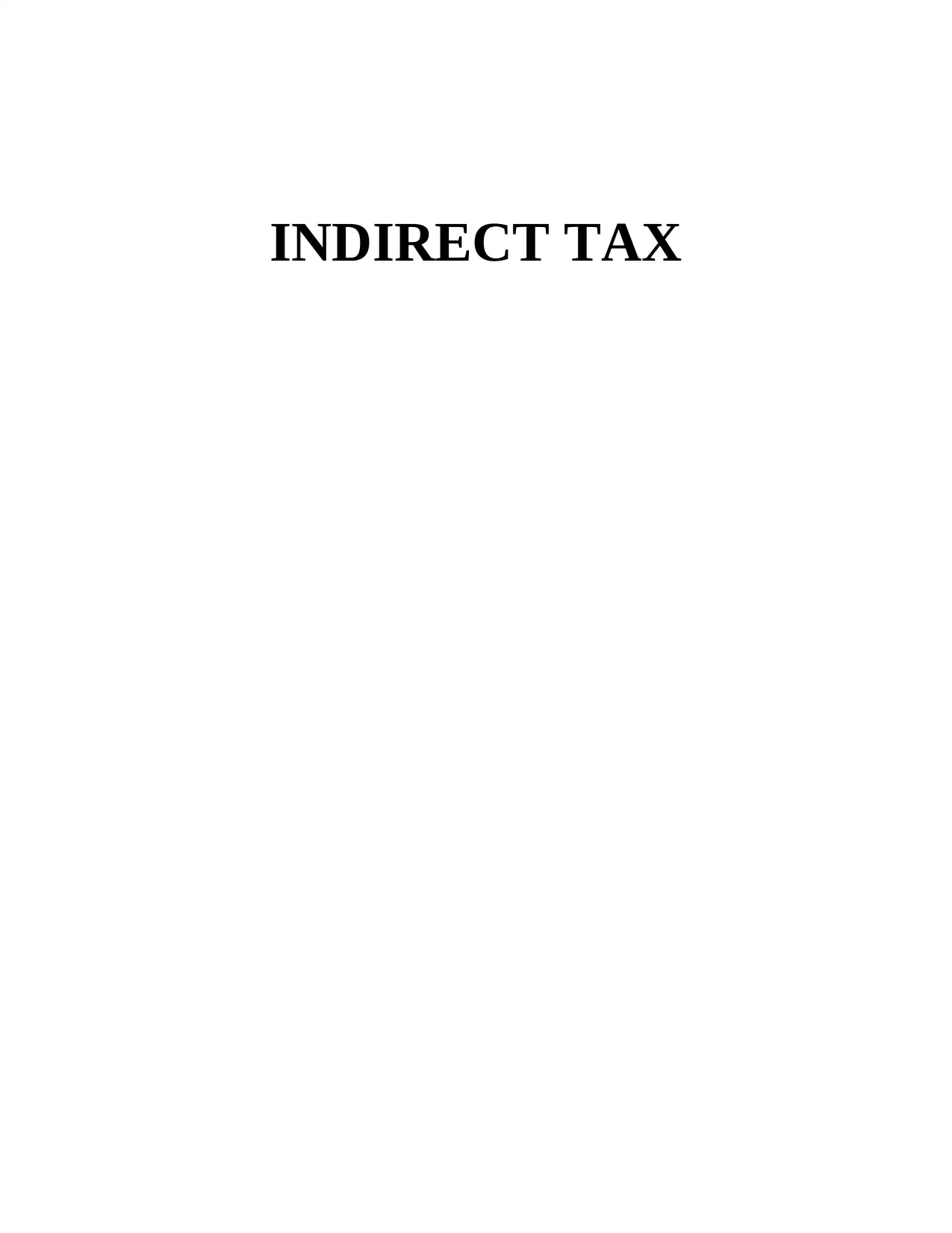
INDIRECT TAX
Paraphrase This Document
Need a fresh take? Get an instant paraphrase of this document with our AI Paraphraser
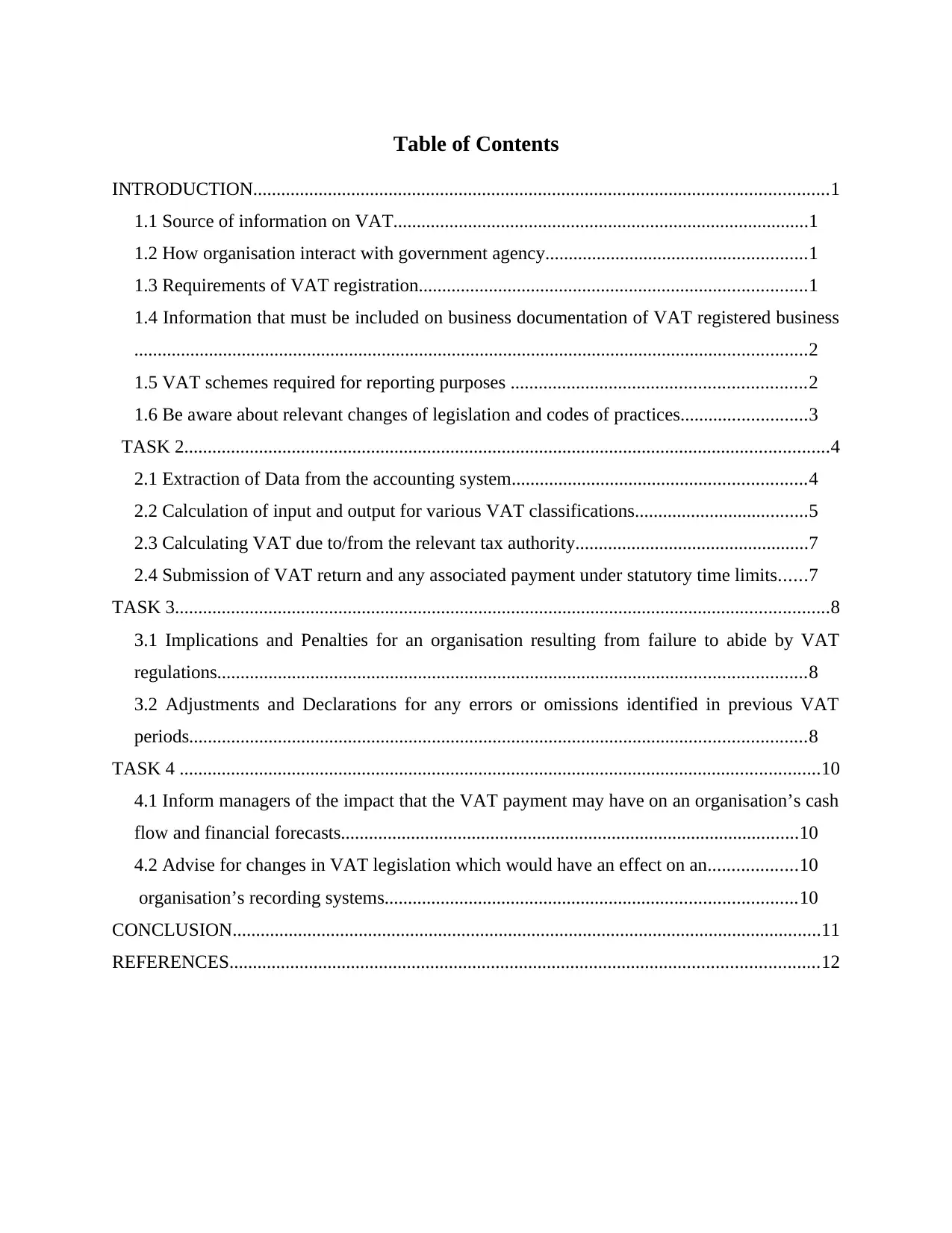
Table of Contents
INTRODUCTION...........................................................................................................................1
1.1 Source of information on VAT.........................................................................................1
1.2 How organisation interact with government agency........................................................1
1.3 Requirements of VAT registration...................................................................................1
1.4 Information that must be included on business documentation of VAT registered business
................................................................................................................................................2
1.5 VAT schemes required for reporting purposes ...............................................................2
1.6 Be aware about relevant changes of legislation and codes of practices...........................3
TASK 2..........................................................................................................................................4
2.1 Extraction of Data from the accounting system...............................................................4
2.2 Calculation of input and output for various VAT classifications.....................................5
2.3 Calculating VAT due to/from the relevant tax authority..................................................7
2.4 Submission of VAT return and any associated payment under statutory time limits......7
TASK 3............................................................................................................................................8
3.1 Implications and Penalties for an organisation resulting from failure to abide by VAT
regulations..............................................................................................................................8
3.2 Adjustments and Declarations for any errors or omissions identified in previous VAT
periods....................................................................................................................................8
TASK 4 .........................................................................................................................................10
4.1 Inform managers of the impact that the VAT payment may have on an organisation’s cash
flow and financial forecasts..................................................................................................10
4.2 Advise for changes in VAT legislation which would have an effect on an...................10
organisation’s recording systems........................................................................................10
CONCLUSION..............................................................................................................................11
REFERENCES..............................................................................................................................12
INTRODUCTION...........................................................................................................................1
1.1 Source of information on VAT.........................................................................................1
1.2 How organisation interact with government agency........................................................1
1.3 Requirements of VAT registration...................................................................................1
1.4 Information that must be included on business documentation of VAT registered business
................................................................................................................................................2
1.5 VAT schemes required for reporting purposes ...............................................................2
1.6 Be aware about relevant changes of legislation and codes of practices...........................3
TASK 2..........................................................................................................................................4
2.1 Extraction of Data from the accounting system...............................................................4
2.2 Calculation of input and output for various VAT classifications.....................................5
2.3 Calculating VAT due to/from the relevant tax authority..................................................7
2.4 Submission of VAT return and any associated payment under statutory time limits......7
TASK 3............................................................................................................................................8
3.1 Implications and Penalties for an organisation resulting from failure to abide by VAT
regulations..............................................................................................................................8
3.2 Adjustments and Declarations for any errors or omissions identified in previous VAT
periods....................................................................................................................................8
TASK 4 .........................................................................................................................................10
4.1 Inform managers of the impact that the VAT payment may have on an organisation’s cash
flow and financial forecasts..................................................................................................10
4.2 Advise for changes in VAT legislation which would have an effect on an...................10
organisation’s recording systems........................................................................................10
CONCLUSION..............................................................................................................................11
REFERENCES..............................................................................................................................12
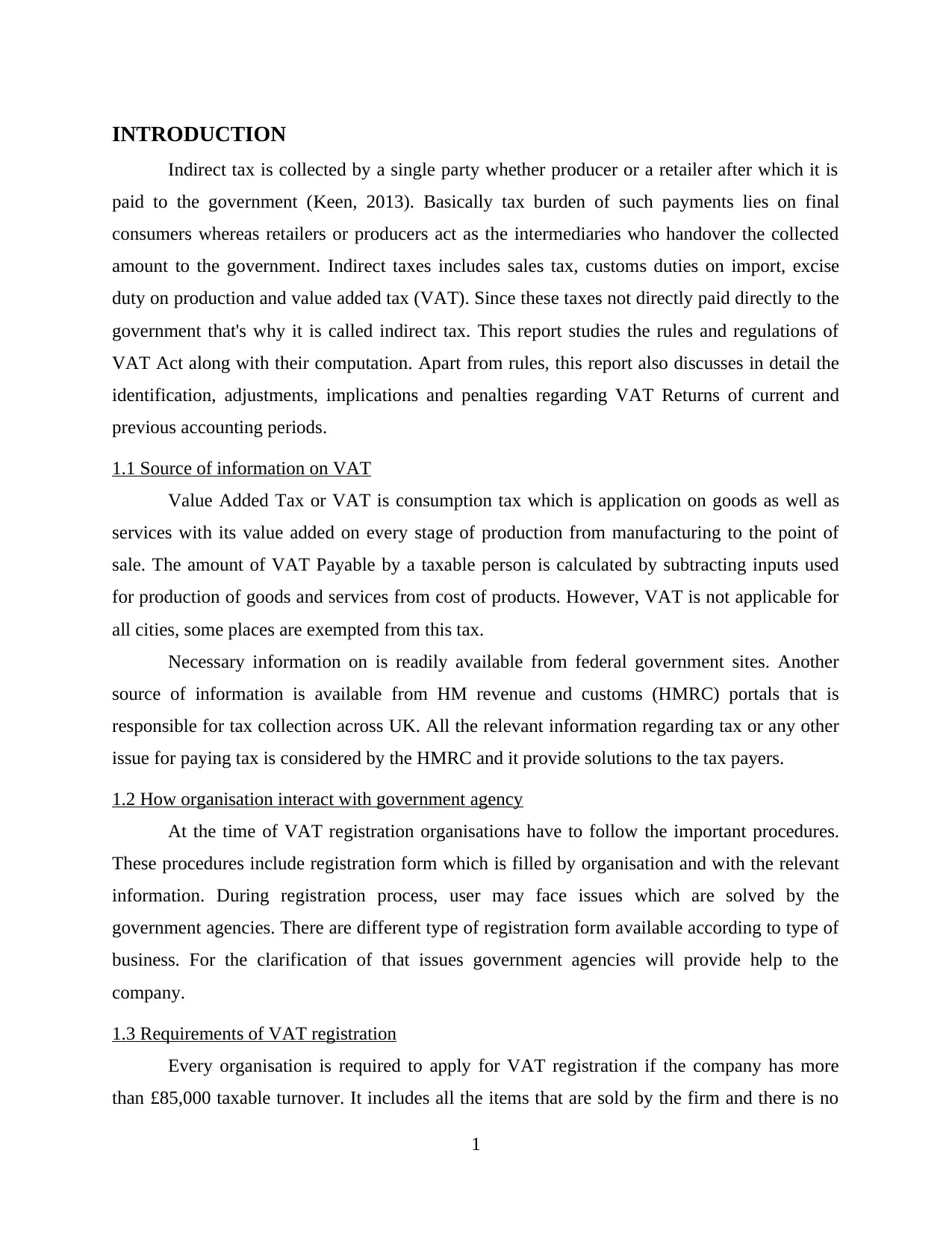
INTRODUCTION
Indirect tax is collected by a single party whether producer or a retailer after which it is
paid to the government (Keen, 2013). Basically tax burden of such payments lies on final
consumers whereas retailers or producers act as the intermediaries who handover the collected
amount to the government. Indirect taxes includes sales tax, customs duties on import, excise
duty on production and value added tax (VAT). Since these taxes not directly paid directly to the
government that's why it is called indirect tax. This report studies the rules and regulations of
VAT Act along with their computation. Apart from rules, this report also discusses in detail the
identification, adjustments, implications and penalties regarding VAT Returns of current and
previous accounting periods.
1.1 Source of information on VAT
Value Added Tax or VAT is consumption tax which is application on goods as well as
services with its value added on every stage of production from manufacturing to the point of
sale. The amount of VAT Payable by a taxable person is calculated by subtracting inputs used
for production of goods and services from cost of products. However, VAT is not applicable for
all cities, some places are exempted from this tax.
Necessary information on is readily available from federal government sites. Another
source of information is available from HM revenue and customs (HMRC) portals that is
responsible for tax collection across UK. All the relevant information regarding tax or any other
issue for paying tax is considered by the HMRC and it provide solutions to the tax payers.
1.2 How organisation interact with government agency
At the time of VAT registration organisations have to follow the important procedures.
These procedures include registration form which is filled by organisation and with the relevant
information. During registration process, user may face issues which are solved by the
government agencies. There are different type of registration form available according to type of
business. For the clarification of that issues government agencies will provide help to the
company.
1.3 Requirements of VAT registration
Every organisation is required to apply for VAT registration if the company has more
than £85,000 taxable turnover. It includes all the items that are sold by the firm and there is no
1
Indirect tax is collected by a single party whether producer or a retailer after which it is
paid to the government (Keen, 2013). Basically tax burden of such payments lies on final
consumers whereas retailers or producers act as the intermediaries who handover the collected
amount to the government. Indirect taxes includes sales tax, customs duties on import, excise
duty on production and value added tax (VAT). Since these taxes not directly paid directly to the
government that's why it is called indirect tax. This report studies the rules and regulations of
VAT Act along with their computation. Apart from rules, this report also discusses in detail the
identification, adjustments, implications and penalties regarding VAT Returns of current and
previous accounting periods.
1.1 Source of information on VAT
Value Added Tax or VAT is consumption tax which is application on goods as well as
services with its value added on every stage of production from manufacturing to the point of
sale. The amount of VAT Payable by a taxable person is calculated by subtracting inputs used
for production of goods and services from cost of products. However, VAT is not applicable for
all cities, some places are exempted from this tax.
Necessary information on is readily available from federal government sites. Another
source of information is available from HM revenue and customs (HMRC) portals that is
responsible for tax collection across UK. All the relevant information regarding tax or any other
issue for paying tax is considered by the HMRC and it provide solutions to the tax payers.
1.2 How organisation interact with government agency
At the time of VAT registration organisations have to follow the important procedures.
These procedures include registration form which is filled by organisation and with the relevant
information. During registration process, user may face issues which are solved by the
government agencies. There are different type of registration form available according to type of
business. For the clarification of that issues government agencies will provide help to the
company.
1.3 Requirements of VAT registration
Every organisation is required to apply for VAT registration if the company has more
than £85,000 taxable turnover. It includes all the items that are sold by the firm and there is no
1
⊘ This is a preview!⊘
Do you want full access?
Subscribe today to unlock all pages.

Trusted by 1+ million students worldwide
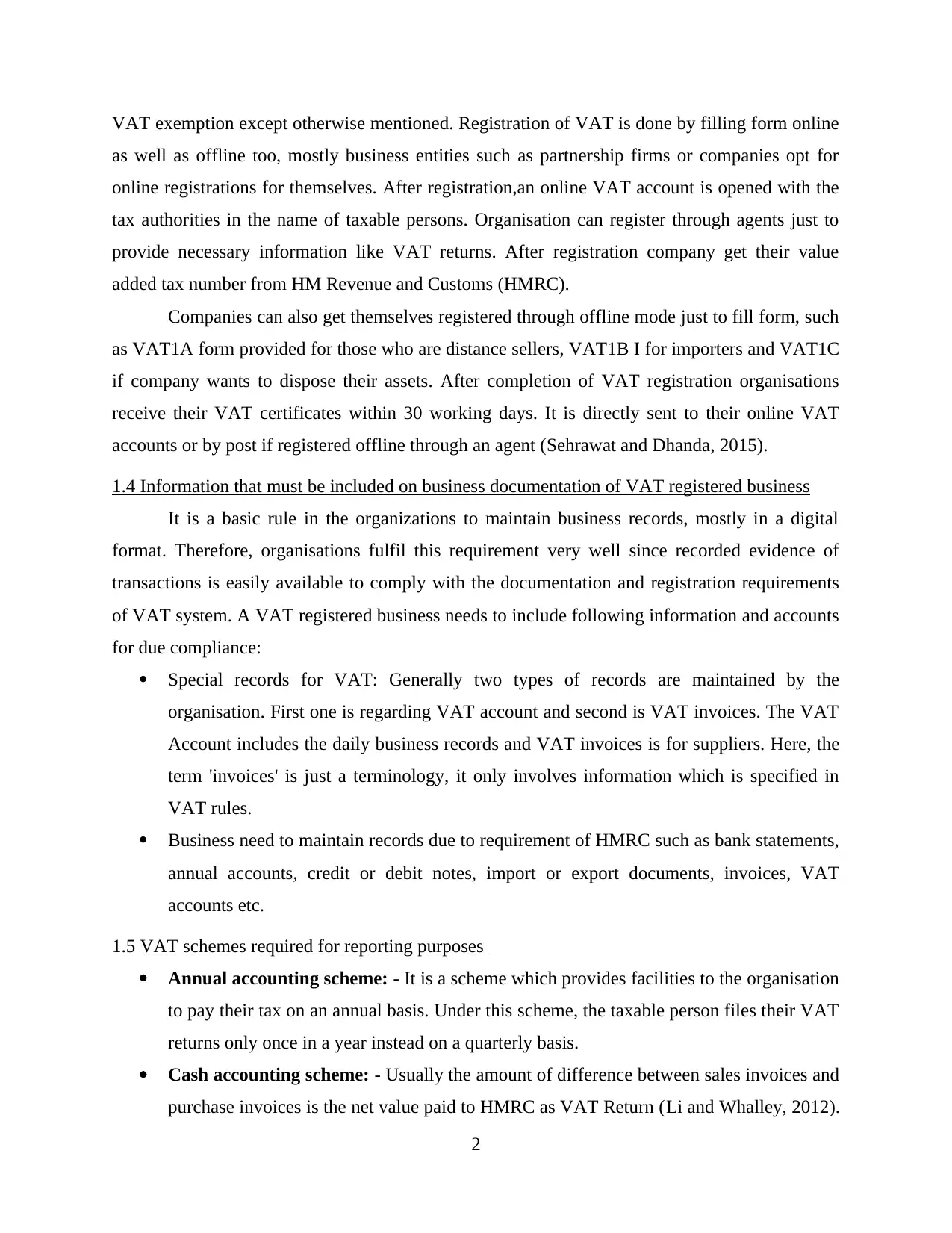
VAT exemption except otherwise mentioned. Registration of VAT is done by filling form online
as well as offline too, mostly business entities such as partnership firms or companies opt for
online registrations for themselves. After registration,an online VAT account is opened with the
tax authorities in the name of taxable persons. Organisation can register through agents just to
provide necessary information like VAT returns. After registration company get their value
added tax number from HM Revenue and Customs (HMRC).
Companies can also get themselves registered through offline mode just to fill form, such
as VAT1A form provided for those who are distance sellers, VAT1B I for importers and VAT1C
if company wants to dispose their assets. After completion of VAT registration organisations
receive their VAT certificates within 30 working days. It is directly sent to their online VAT
accounts or by post if registered offline through an agent (Sehrawat and Dhanda, 2015).
1.4 Information that must be included on business documentation of VAT registered business
It is a basic rule in the organizations to maintain business records, mostly in a digital
format. Therefore, organisations fulfil this requirement very well since recorded evidence of
transactions is easily available to comply with the documentation and registration requirements
of VAT system. A VAT registered business needs to include following information and accounts
for due compliance:
Special records for VAT: Generally two types of records are maintained by the
organisation. First one is regarding VAT account and second is VAT invoices. The VAT
Account includes the daily business records and VAT invoices is for suppliers. Here, the
term 'invoices' is just a terminology, it only involves information which is specified in
VAT rules.
Business need to maintain records due to requirement of HMRC such as bank statements,
annual accounts, credit or debit notes, import or export documents, invoices, VAT
accounts etc.
1.5 VAT schemes required for reporting purposes
Annual accounting scheme: - It is a scheme which provides facilities to the organisation
to pay their tax on an annual basis. Under this scheme, the taxable person files their VAT
returns only once in a year instead on a quarterly basis.
Cash accounting scheme: - Usually the amount of difference between sales invoices and
purchase invoices is the net value paid to HMRC as VAT Return (Li and Whalley, 2012).
2
as well as offline too, mostly business entities such as partnership firms or companies opt for
online registrations for themselves. After registration,an online VAT account is opened with the
tax authorities in the name of taxable persons. Organisation can register through agents just to
provide necessary information like VAT returns. After registration company get their value
added tax number from HM Revenue and Customs (HMRC).
Companies can also get themselves registered through offline mode just to fill form, such
as VAT1A form provided for those who are distance sellers, VAT1B I for importers and VAT1C
if company wants to dispose their assets. After completion of VAT registration organisations
receive their VAT certificates within 30 working days. It is directly sent to their online VAT
accounts or by post if registered offline through an agent (Sehrawat and Dhanda, 2015).
1.4 Information that must be included on business documentation of VAT registered business
It is a basic rule in the organizations to maintain business records, mostly in a digital
format. Therefore, organisations fulfil this requirement very well since recorded evidence of
transactions is easily available to comply with the documentation and registration requirements
of VAT system. A VAT registered business needs to include following information and accounts
for due compliance:
Special records for VAT: Generally two types of records are maintained by the
organisation. First one is regarding VAT account and second is VAT invoices. The VAT
Account includes the daily business records and VAT invoices is for suppliers. Here, the
term 'invoices' is just a terminology, it only involves information which is specified in
VAT rules.
Business need to maintain records due to requirement of HMRC such as bank statements,
annual accounts, credit or debit notes, import or export documents, invoices, VAT
accounts etc.
1.5 VAT schemes required for reporting purposes
Annual accounting scheme: - It is a scheme which provides facilities to the organisation
to pay their tax on an annual basis. Under this scheme, the taxable person files their VAT
returns only once in a year instead on a quarterly basis.
Cash accounting scheme: - Usually the amount of difference between sales invoices and
purchase invoices is the net value paid to HMRC as VAT Return (Li and Whalley, 2012).
2
Paraphrase This Document
Need a fresh take? Get an instant paraphrase of this document with our AI Paraphraser
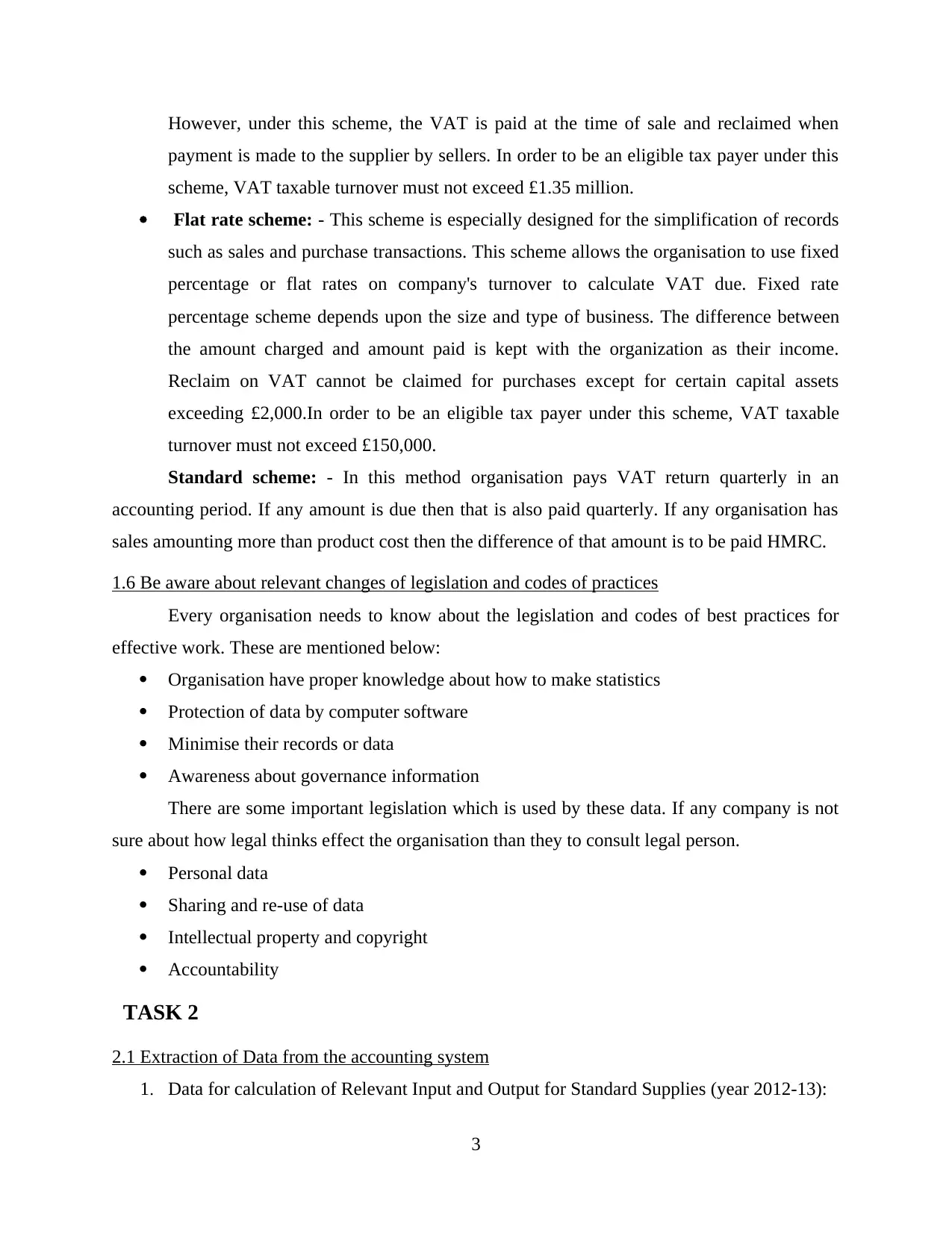
However, under this scheme, the VAT is paid at the time of sale and reclaimed when
payment is made to the supplier by sellers. In order to be an eligible tax payer under this
scheme, VAT taxable turnover must not exceed £1.35 million.
Flat rate scheme: - This scheme is especially designed for the simplification of records
such as sales and purchase transactions. This scheme allows the organisation to use fixed
percentage or flat rates on company's turnover to calculate VAT due. Fixed rate
percentage scheme depends upon the size and type of business. The difference between
the amount charged and amount paid is kept with the organization as their income.
Reclaim on VAT cannot be claimed for purchases except for certain capital assets
exceeding £2,000.In order to be an eligible tax payer under this scheme, VAT taxable
turnover must not exceed £150,000.
Standard scheme: - In this method organisation pays VAT return quarterly in an
accounting period. If any amount is due then that is also paid quarterly. If any organisation has
sales amounting more than product cost then the difference of that amount is to be paid HMRC.
1.6 Be aware about relevant changes of legislation and codes of practices
Every organisation needs to know about the legislation and codes of best practices for
effective work. These are mentioned below:
Organisation have proper knowledge about how to make statistics
Protection of data by computer software
Minimise their records or data
Awareness about governance information
There are some important legislation which is used by these data. If any company is not
sure about how legal thinks effect the organisation than they to consult legal person.
Personal data
Sharing and re-use of data
Intellectual property and copyright
Accountability
TASK 2
2.1 Extraction of Data from the accounting system
1. Data for calculation of Relevant Input and Output for Standard Supplies (year 2012-13):
3
payment is made to the supplier by sellers. In order to be an eligible tax payer under this
scheme, VAT taxable turnover must not exceed £1.35 million.
Flat rate scheme: - This scheme is especially designed for the simplification of records
such as sales and purchase transactions. This scheme allows the organisation to use fixed
percentage or flat rates on company's turnover to calculate VAT due. Fixed rate
percentage scheme depends upon the size and type of business. The difference between
the amount charged and amount paid is kept with the organization as their income.
Reclaim on VAT cannot be claimed for purchases except for certain capital assets
exceeding £2,000.In order to be an eligible tax payer under this scheme, VAT taxable
turnover must not exceed £150,000.
Standard scheme: - In this method organisation pays VAT return quarterly in an
accounting period. If any amount is due then that is also paid quarterly. If any organisation has
sales amounting more than product cost then the difference of that amount is to be paid HMRC.
1.6 Be aware about relevant changes of legislation and codes of practices
Every organisation needs to know about the legislation and codes of best practices for
effective work. These are mentioned below:
Organisation have proper knowledge about how to make statistics
Protection of data by computer software
Minimise their records or data
Awareness about governance information
There are some important legislation which is used by these data. If any company is not
sure about how legal thinks effect the organisation than they to consult legal person.
Personal data
Sharing and re-use of data
Intellectual property and copyright
Accountability
TASK 2
2.1 Extraction of Data from the accounting system
1. Data for calculation of Relevant Input and Output for Standard Supplies (year 2012-13):
3
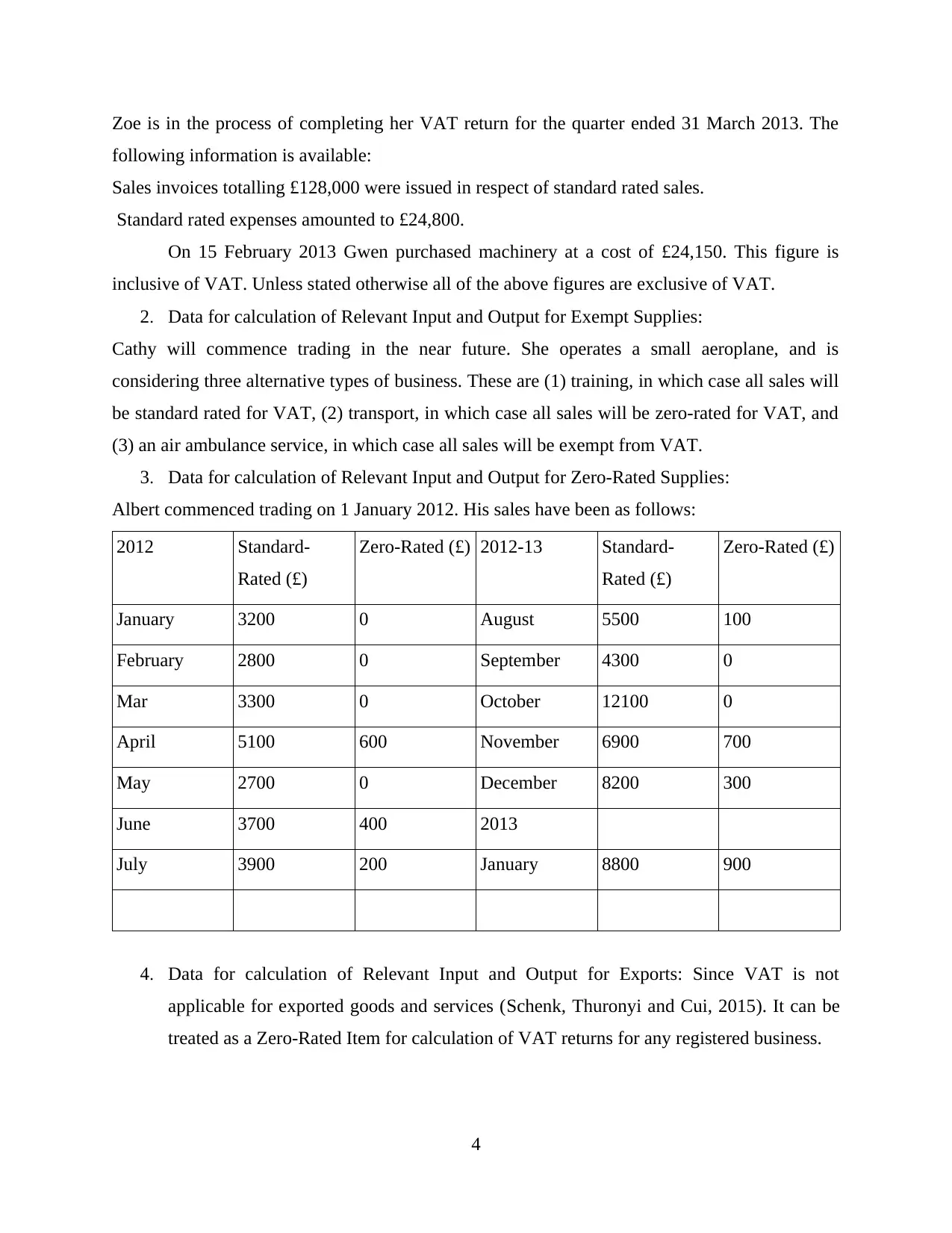
Zoe is in the process of completing her VAT return for the quarter ended 31 March 2013. The
following information is available:
Sales invoices totalling £128,000 were issued in respect of standard rated sales.
Standard rated expenses amounted to £24,800.
On 15 February 2013 Gwen purchased machinery at a cost of £24,150. This figure is
inclusive of VAT. Unless stated otherwise all of the above figures are exclusive of VAT.
2. Data for calculation of Relevant Input and Output for Exempt Supplies:
Cathy will commence trading in the near future. She operates a small aeroplane, and is
considering three alternative types of business. These are (1) training, in which case all sales will
be standard rated for VAT, (2) transport, in which case all sales will be zero-rated for VAT, and
(3) an air ambulance service, in which case all sales will be exempt from VAT.
3. Data for calculation of Relevant Input and Output for Zero-Rated Supplies:
Albert commenced trading on 1 January 2012. His sales have been as follows:
2012 Standard-
Rated (£)
Zero-Rated (£) 2012-13 Standard-
Rated (£)
Zero-Rated (£)
January 3200 0 August 5500 100
February 2800 0 September 4300 0
Mar 3300 0 October 12100 0
April 5100 600 November 6900 700
May 2700 0 December 8200 300
June 3700 400 2013
July 3900 200 January 8800 900
4. Data for calculation of Relevant Input and Output for Exports: Since VAT is not
applicable for exported goods and services (Schenk, Thuronyi and Cui, 2015). It can be
treated as a Zero-Rated Item for calculation of VAT returns for any registered business.
4
following information is available:
Sales invoices totalling £128,000 were issued in respect of standard rated sales.
Standard rated expenses amounted to £24,800.
On 15 February 2013 Gwen purchased machinery at a cost of £24,150. This figure is
inclusive of VAT. Unless stated otherwise all of the above figures are exclusive of VAT.
2. Data for calculation of Relevant Input and Output for Exempt Supplies:
Cathy will commence trading in the near future. She operates a small aeroplane, and is
considering three alternative types of business. These are (1) training, in which case all sales will
be standard rated for VAT, (2) transport, in which case all sales will be zero-rated for VAT, and
(3) an air ambulance service, in which case all sales will be exempt from VAT.
3. Data for calculation of Relevant Input and Output for Zero-Rated Supplies:
Albert commenced trading on 1 January 2012. His sales have been as follows:
2012 Standard-
Rated (£)
Zero-Rated (£) 2012-13 Standard-
Rated (£)
Zero-Rated (£)
January 3200 0 August 5500 100
February 2800 0 September 4300 0
Mar 3300 0 October 12100 0
April 5100 600 November 6900 700
May 2700 0 December 8200 300
June 3700 400 2013
July 3900 200 January 8800 900
4. Data for calculation of Relevant Input and Output for Exports: Since VAT is not
applicable for exported goods and services (Schenk, Thuronyi and Cui, 2015). It can be
treated as a Zero-Rated Item for calculation of VAT returns for any registered business.
4
⊘ This is a preview!⊘
Do you want full access?
Subscribe today to unlock all pages.

Trusted by 1+ million students worldwide
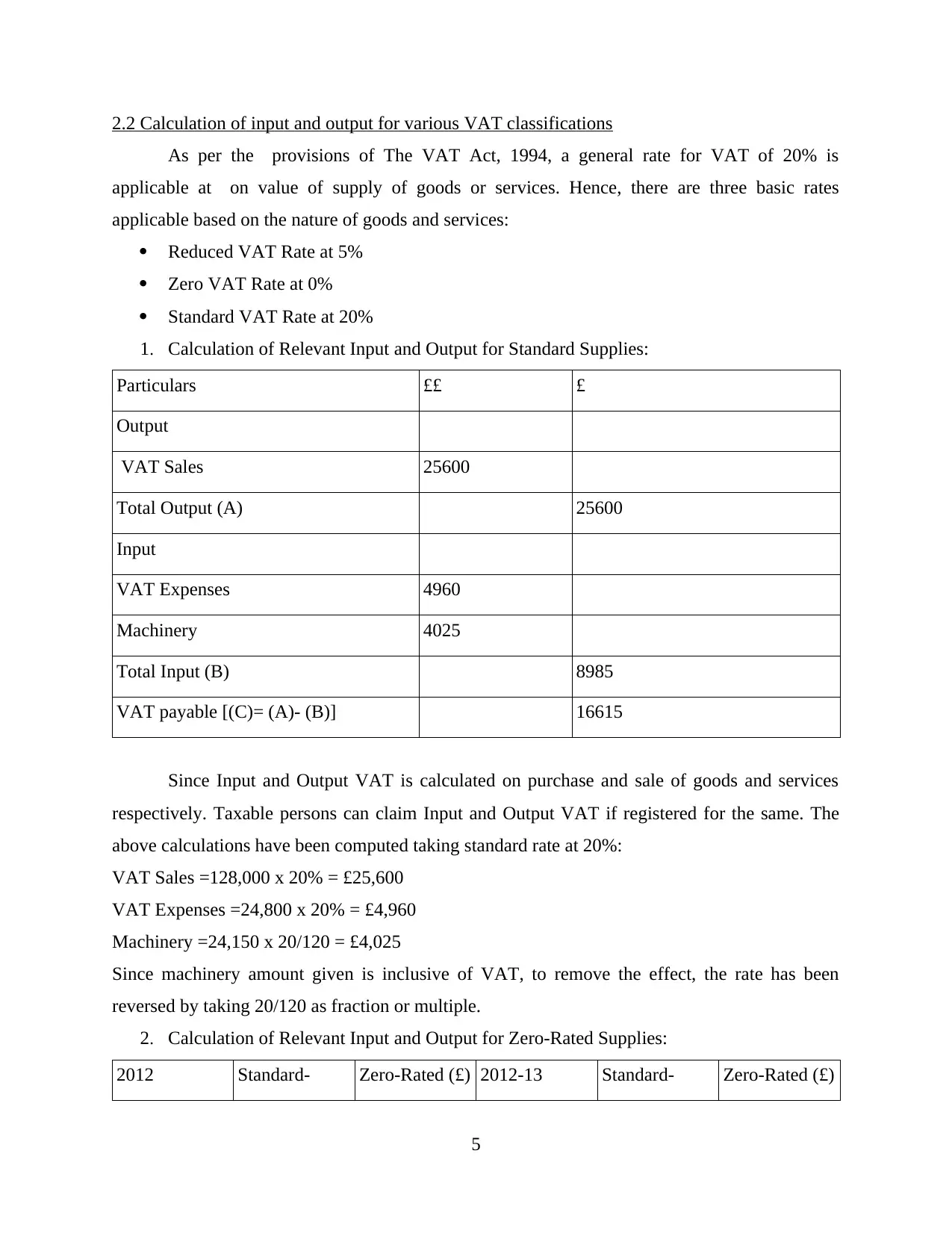
2.2 Calculation of input and output for various VAT classifications
As per the provisions of The VAT Act, 1994, a general rate for VAT of 20% is
applicable at on value of supply of goods or services. Hence, there are three basic rates
applicable based on the nature of goods and services:
Reduced VAT Rate at 5%
Zero VAT Rate at 0%
Standard VAT Rate at 20%
1. Calculation of Relevant Input and Output for Standard Supplies:
Particulars ££ £
Output
VAT Sales 25600
Total Output (A) 25600
Input
VAT Expenses 4960
Machinery 4025
Total Input (B) 8985
VAT payable [(C)= (A)- (B)] 16615
Since Input and Output VAT is calculated on purchase and sale of goods and services
respectively. Taxable persons can claim Input and Output VAT if registered for the same. The
above calculations have been computed taking standard rate at 20%:
VAT Sales =128,000 x 20% = £25,600
VAT Expenses =24,800 x 20% = £4,960
Machinery =24,150 x 20/120 = £4,025
Since machinery amount given is inclusive of VAT, to remove the effect, the rate has been
reversed by taking 20/120 as fraction or multiple.
2. Calculation of Relevant Input and Output for Zero-Rated Supplies:
2012 Standard- Zero-Rated (£) 2012-13 Standard- Zero-Rated (£)
5
As per the provisions of The VAT Act, 1994, a general rate for VAT of 20% is
applicable at on value of supply of goods or services. Hence, there are three basic rates
applicable based on the nature of goods and services:
Reduced VAT Rate at 5%
Zero VAT Rate at 0%
Standard VAT Rate at 20%
1. Calculation of Relevant Input and Output for Standard Supplies:
Particulars ££ £
Output
VAT Sales 25600
Total Output (A) 25600
Input
VAT Expenses 4960
Machinery 4025
Total Input (B) 8985
VAT payable [(C)= (A)- (B)] 16615
Since Input and Output VAT is calculated on purchase and sale of goods and services
respectively. Taxable persons can claim Input and Output VAT if registered for the same. The
above calculations have been computed taking standard rate at 20%:
VAT Sales =128,000 x 20% = £25,600
VAT Expenses =24,800 x 20% = £4,960
Machinery =24,150 x 20/120 = £4,025
Since machinery amount given is inclusive of VAT, to remove the effect, the rate has been
reversed by taking 20/120 as fraction or multiple.
2. Calculation of Relevant Input and Output for Zero-Rated Supplies:
2012 Standard- Zero-Rated (£) 2012-13 Standard- Zero-Rated (£)
5
Paraphrase This Document
Need a fresh take? Get an instant paraphrase of this document with our AI Paraphraser
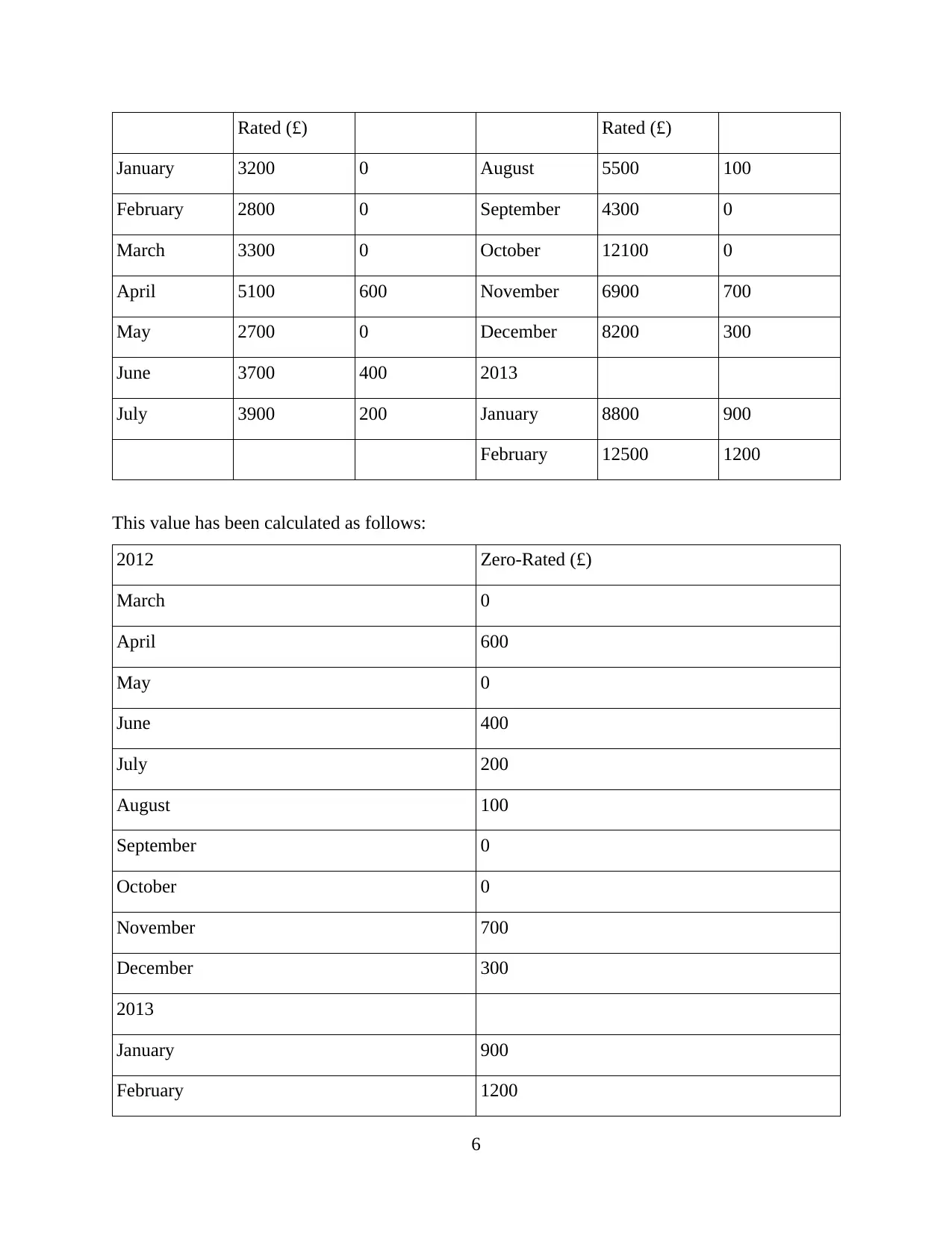
Rated (£) Rated (£)
January 3200 0 August 5500 100
February 2800 0 September 4300 0
March 3300 0 October 12100 0
April 5100 600 November 6900 700
May 2700 0 December 8200 300
June 3700 400 2013
July 3900 200 January 8800 900
February 12500 1200
This value has been calculated as follows:
2012 Zero-Rated (£)
March 0
April 600
May 0
June 400
July 200
August 100
September 0
October 0
November 700
December 300
2013
January 900
February 1200
6
January 3200 0 August 5500 100
February 2800 0 September 4300 0
March 3300 0 October 12100 0
April 5100 600 November 6900 700
May 2700 0 December 8200 300
June 3700 400 2013
July 3900 200 January 8800 900
February 12500 1200
This value has been calculated as follows:
2012 Zero-Rated (£)
March 0
April 600
May 0
June 400
July 200
August 100
September 0
October 0
November 700
December 300
2013
January 900
February 1200
6
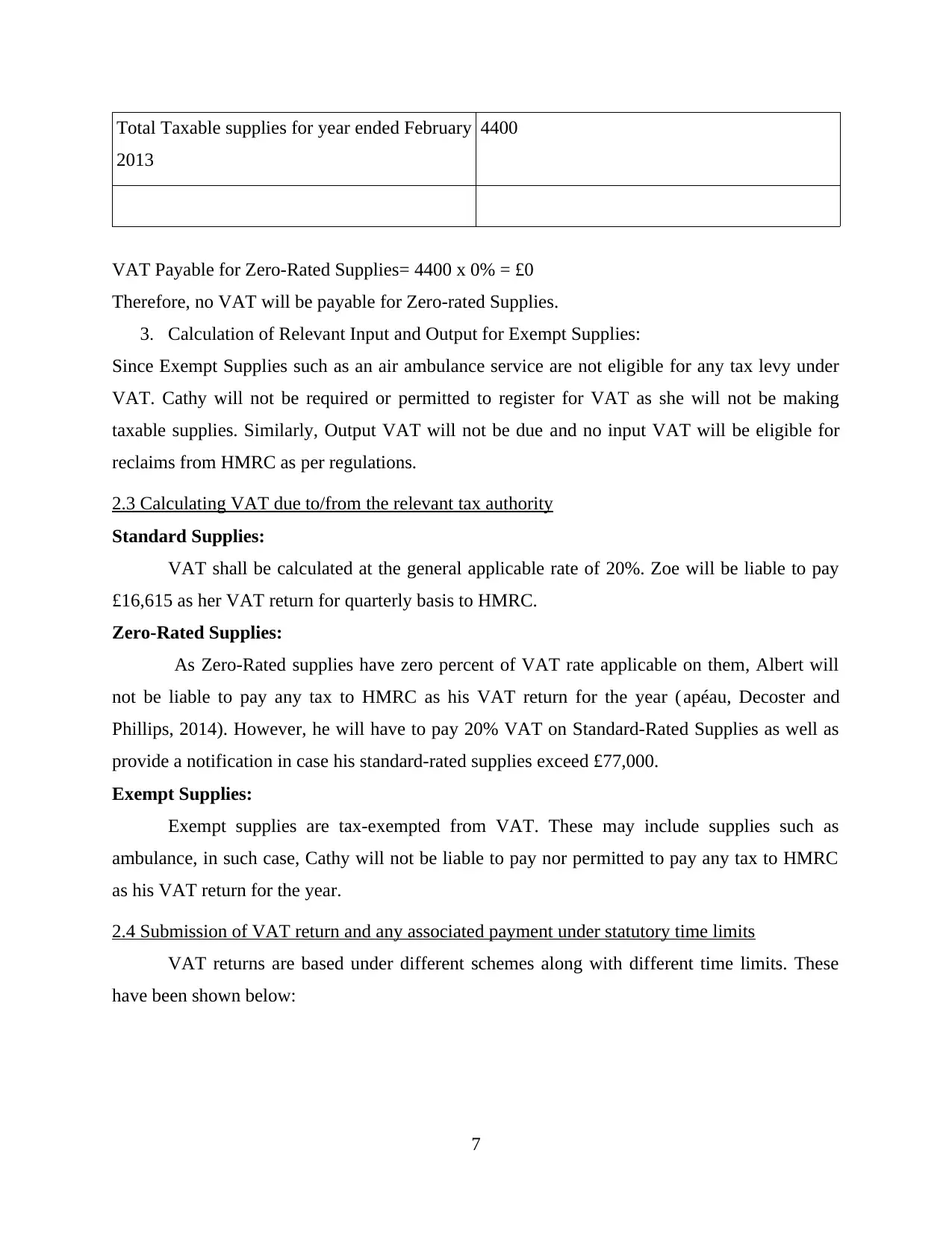
Total Taxable supplies for year ended February
2013
4400
VAT Payable for Zero-Rated Supplies= 4400 x 0% = £0
Therefore, no VAT will be payable for Zero-rated Supplies.
3. Calculation of Relevant Input and Output for Exempt Supplies:
Since Exempt Supplies such as an air ambulance service are not eligible for any tax levy under
VAT. Cathy will not be required or permitted to register for VAT as she will not be making
taxable supplies. Similarly, Output VAT will not be due and no input VAT will be eligible for
reclaims from HMRC as per regulations.
2.3 Calculating VAT due to/from the relevant tax authority
Standard Supplies:
VAT shall be calculated at the general applicable rate of 20%. Zoe will be liable to pay
£16,615 as her VAT return for quarterly basis to HMRC.
Zero-Rated Supplies:
As Zero-Rated supplies have zero percent of VAT rate applicable on them, Albert will
not be liable to pay any tax to HMRC as his VAT return for the year ( apéau, Decoster and
Phillips, 2014). However, he will have to pay 20% VAT on Standard-Rated Supplies as well as
provide a notification in case his standard-rated supplies exceed £77,000.
Exempt Supplies:
Exempt supplies are tax-exempted from VAT. These may include supplies such as
ambulance, in such case, Cathy will not be liable to pay nor permitted to pay any tax to HMRC
as his VAT return for the year.
2.4 Submission of VAT return and any associated payment under statutory time limits
VAT returns are based under different schemes along with different time limits. These
have been shown below:
7
2013
4400
VAT Payable for Zero-Rated Supplies= 4400 x 0% = £0
Therefore, no VAT will be payable for Zero-rated Supplies.
3. Calculation of Relevant Input and Output for Exempt Supplies:
Since Exempt Supplies such as an air ambulance service are not eligible for any tax levy under
VAT. Cathy will not be required or permitted to register for VAT as she will not be making
taxable supplies. Similarly, Output VAT will not be due and no input VAT will be eligible for
reclaims from HMRC as per regulations.
2.3 Calculating VAT due to/from the relevant tax authority
Standard Supplies:
VAT shall be calculated at the general applicable rate of 20%. Zoe will be liable to pay
£16,615 as her VAT return for quarterly basis to HMRC.
Zero-Rated Supplies:
As Zero-Rated supplies have zero percent of VAT rate applicable on them, Albert will
not be liable to pay any tax to HMRC as his VAT return for the year ( apéau, Decoster and
Phillips, 2014). However, he will have to pay 20% VAT on Standard-Rated Supplies as well as
provide a notification in case his standard-rated supplies exceed £77,000.
Exempt Supplies:
Exempt supplies are tax-exempted from VAT. These may include supplies such as
ambulance, in such case, Cathy will not be liable to pay nor permitted to pay any tax to HMRC
as his VAT return for the year.
2.4 Submission of VAT return and any associated payment under statutory time limits
VAT returns are based under different schemes along with different time limits. These
have been shown below:
7
⊘ This is a preview!⊘
Do you want full access?
Subscribe today to unlock all pages.

Trusted by 1+ million students worldwide
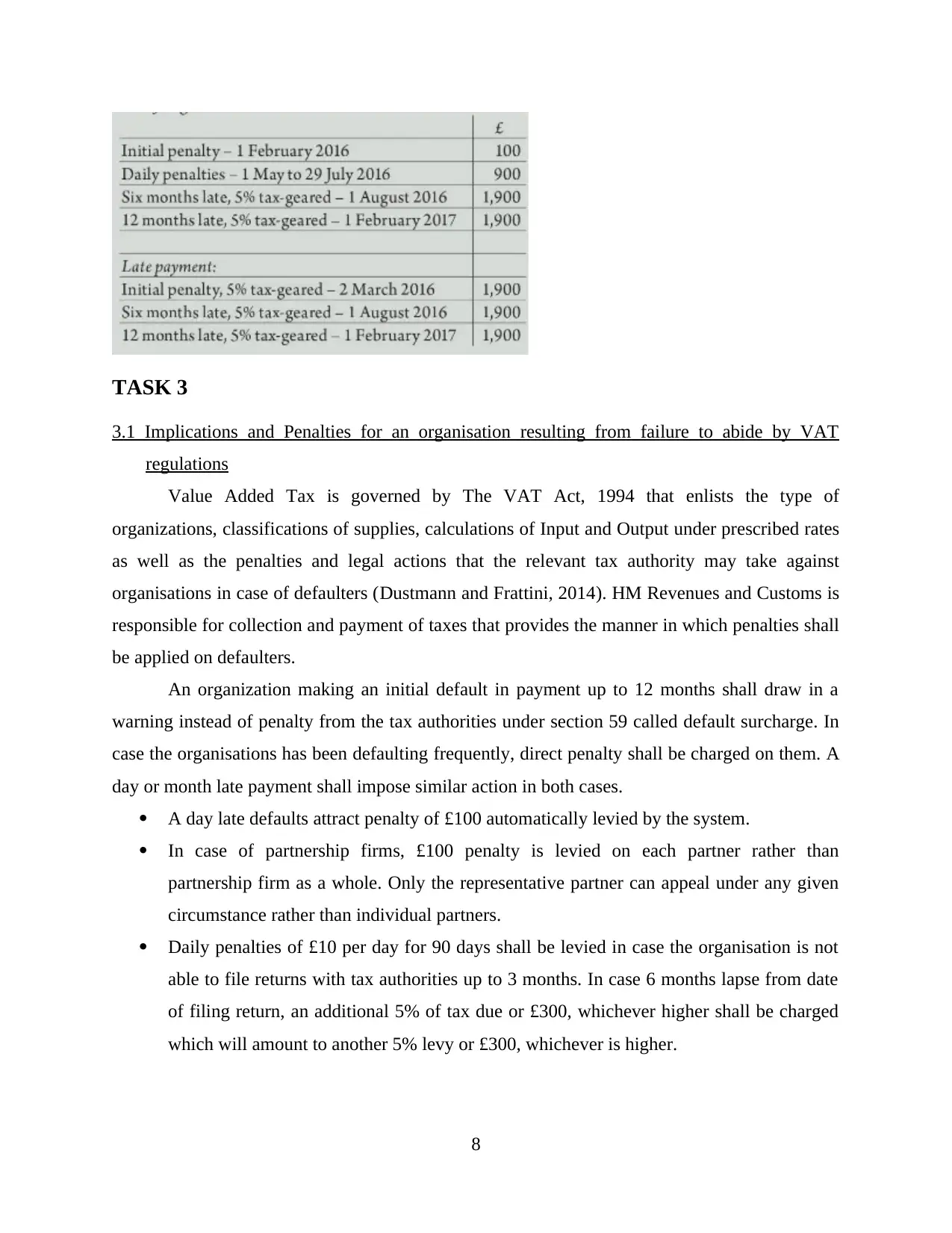
TASK 3
3.1 Implications and Penalties for an organisation resulting from failure to abide by VAT
regulations
Value Added Tax is governed by The VAT Act, 1994 that enlists the type of
organizations, classifications of supplies, calculations of Input and Output under prescribed rates
as well as the penalties and legal actions that the relevant tax authority may take against
organisations in case of defaulters (Dustmann and Frattini, 2014). HM Revenues and Customs is
responsible for collection and payment of taxes that provides the manner in which penalties shall
be applied on defaulters.
An organization making an initial default in payment up to 12 months shall draw in a
warning instead of penalty from the tax authorities under section 59 called default surcharge. In
case the organisations has been defaulting frequently, direct penalty shall be charged on them. A
day or month late payment shall impose similar action in both cases.
A day late defaults attract penalty of £100 automatically levied by the system.
In case of partnership firms, £100 penalty is levied on each partner rather than
partnership firm as a whole. Only the representative partner can appeal under any given
circumstance rather than individual partners.
Daily penalties of £10 per day for 90 days shall be levied in case the organisation is not
able to file returns with tax authorities up to 3 months. In case 6 months lapse from date
of filing return, an additional 5% of tax due or £300, whichever higher shall be charged
which will amount to another 5% levy or £300, whichever is higher.
8
3.1 Implications and Penalties for an organisation resulting from failure to abide by VAT
regulations
Value Added Tax is governed by The VAT Act, 1994 that enlists the type of
organizations, classifications of supplies, calculations of Input and Output under prescribed rates
as well as the penalties and legal actions that the relevant tax authority may take against
organisations in case of defaulters (Dustmann and Frattini, 2014). HM Revenues and Customs is
responsible for collection and payment of taxes that provides the manner in which penalties shall
be applied on defaulters.
An organization making an initial default in payment up to 12 months shall draw in a
warning instead of penalty from the tax authorities under section 59 called default surcharge. In
case the organisations has been defaulting frequently, direct penalty shall be charged on them. A
day or month late payment shall impose similar action in both cases.
A day late defaults attract penalty of £100 automatically levied by the system.
In case of partnership firms, £100 penalty is levied on each partner rather than
partnership firm as a whole. Only the representative partner can appeal under any given
circumstance rather than individual partners.
Daily penalties of £10 per day for 90 days shall be levied in case the organisation is not
able to file returns with tax authorities up to 3 months. In case 6 months lapse from date
of filing return, an additional 5% of tax due or £300, whichever higher shall be charged
which will amount to another 5% levy or £300, whichever is higher.
8
Paraphrase This Document
Need a fresh take? Get an instant paraphrase of this document with our AI Paraphraser
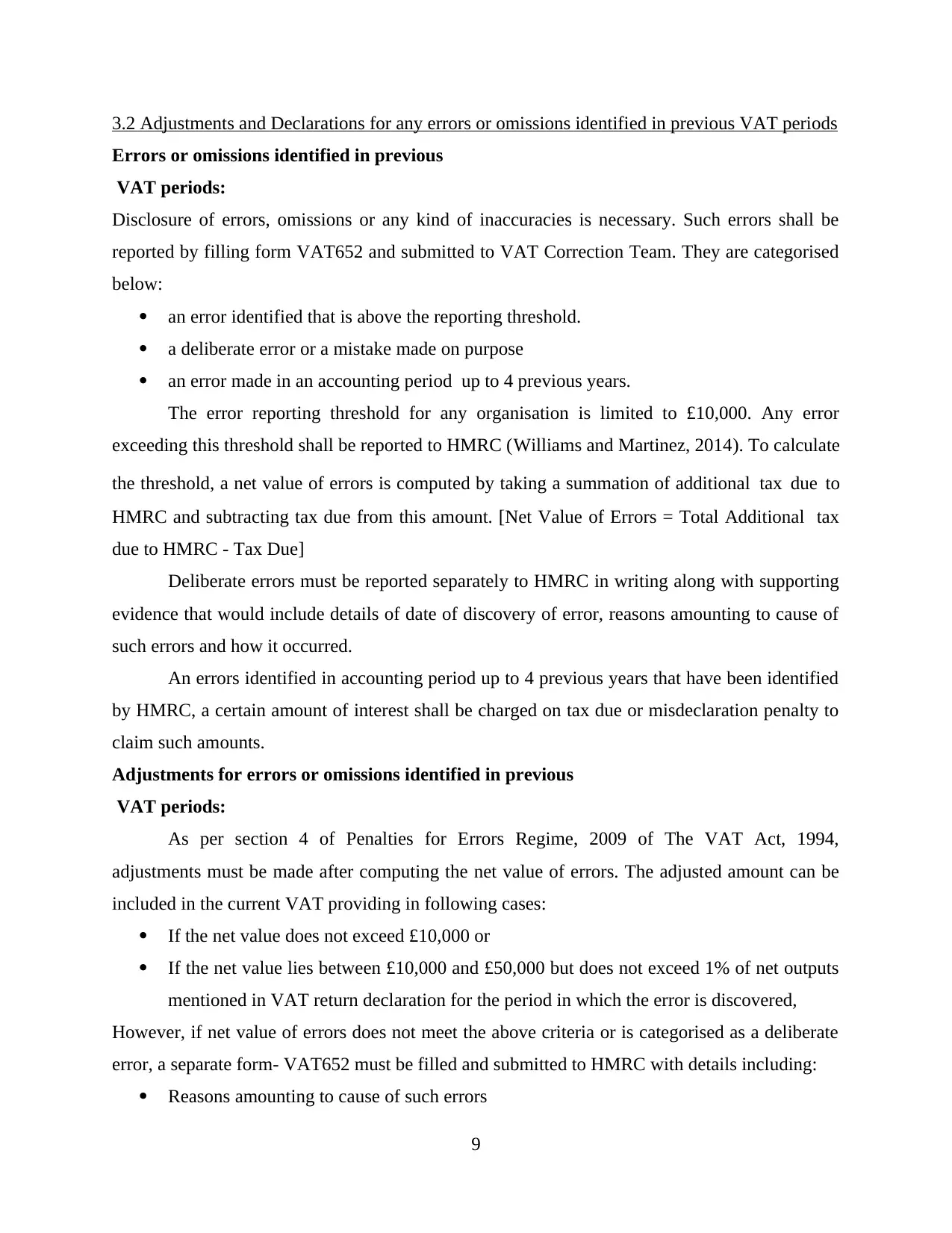
3.2 Adjustments and Declarations for any errors or omissions identified in previous VAT periods
Errors or omissions identified in previous
VAT periods:
Disclosure of errors, omissions or any kind of inaccuracies is necessary. Such errors shall be
reported by filling form VAT652 and submitted to VAT Correction Team. They are categorised
below:
an error identified that is above the reporting threshold.
a deliberate error or a mistake made on purpose
an error made in an accounting period up to 4 previous years.
The error reporting threshold for any organisation is limited to £10,000. Any error
exceeding this threshold shall be reported to HMRC (Williams and Martinez, 2014). To calculate
the threshold, a net value of errors is computed by taking a summation of additional tax due to
HMRC and subtracting tax due from this amount. [Net Value of Errors = Total Additional tax
due to HMRC - Tax Due]
Deliberate errors must be reported separately to HMRC in writing along with supporting
evidence that would include details of date of discovery of error, reasons amounting to cause of
such errors and how it occurred.
An errors identified in accounting period up to 4 previous years that have been identified
by HMRC, a certain amount of interest shall be charged on tax due or misdeclaration penalty to
claim such amounts.
Adjustments for errors or omissions identified in previous
VAT periods:
As per section 4 of Penalties for Errors Regime, 2009 of The VAT Act, 1994,
adjustments must be made after computing the net value of errors. The adjusted amount can be
included in the current VAT providing in following cases:
If the net value does not exceed £10,000 or
If the net value lies between £10,000 and £50,000 but does not exceed 1% of net outputs
mentioned in VAT return declaration for the period in which the error is discovered,
However, if net value of errors does not meet the above criteria or is categorised as a deliberate
error, a separate form- VAT652 must be filled and submitted to HMRC with details including:
Reasons amounting to cause of such errors
9
Errors or omissions identified in previous
VAT periods:
Disclosure of errors, omissions or any kind of inaccuracies is necessary. Such errors shall be
reported by filling form VAT652 and submitted to VAT Correction Team. They are categorised
below:
an error identified that is above the reporting threshold.
a deliberate error or a mistake made on purpose
an error made in an accounting period up to 4 previous years.
The error reporting threshold for any organisation is limited to £10,000. Any error
exceeding this threshold shall be reported to HMRC (Williams and Martinez, 2014). To calculate
the threshold, a net value of errors is computed by taking a summation of additional tax due to
HMRC and subtracting tax due from this amount. [Net Value of Errors = Total Additional tax
due to HMRC - Tax Due]
Deliberate errors must be reported separately to HMRC in writing along with supporting
evidence that would include details of date of discovery of error, reasons amounting to cause of
such errors and how it occurred.
An errors identified in accounting period up to 4 previous years that have been identified
by HMRC, a certain amount of interest shall be charged on tax due or misdeclaration penalty to
claim such amounts.
Adjustments for errors or omissions identified in previous
VAT periods:
As per section 4 of Penalties for Errors Regime, 2009 of The VAT Act, 1994,
adjustments must be made after computing the net value of errors. The adjusted amount can be
included in the current VAT providing in following cases:
If the net value does not exceed £10,000 or
If the net value lies between £10,000 and £50,000 but does not exceed 1% of net outputs
mentioned in VAT return declaration for the period in which the error is discovered,
However, if net value of errors does not meet the above criteria or is categorised as a deliberate
error, a separate form- VAT652 must be filled and submitted to HMRC with details including:
Reasons amounting to cause of such errors
9
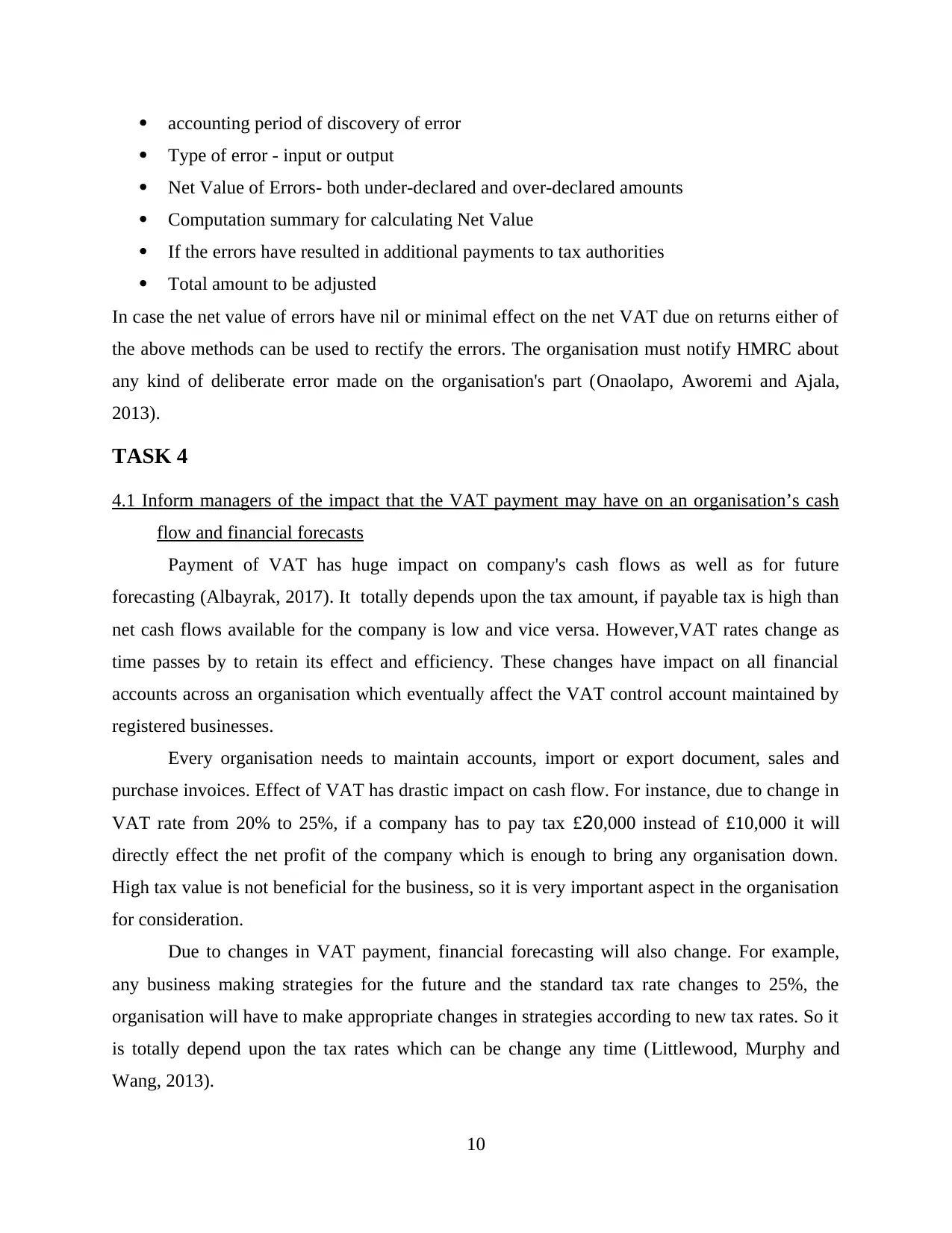
accounting period of discovery of error
Type of error - input or output
Net Value of Errors- both under-declared and over-declared amounts
Computation summary for calculating Net Value
If the errors have resulted in additional payments to tax authorities
Total amount to be adjusted
In case the net value of errors have nil or minimal effect on the net VAT due on returns either of
the above methods can be used to rectify the errors. The organisation must notify HMRC about
any kind of deliberate error made on the organisation's part (Onaolapo, Aworemi and Ajala,
2013).
TASK 4
4.1 Inform managers of the impact that the VAT payment may have on an organisation’s cash
flow and financial forecasts
Payment of VAT has huge impact on company's cash flows as well as for future
forecasting (Albayrak, 2017). It totally depends upon the tax amount, if payable tax is high than
net cash flows available for the company is low and vice versa. However,VAT rates change as
time passes by to retain its effect and efficiency. These changes have impact on all financial
accounts across an organisation which eventually affect the VAT control account maintained by
registered businesses.
Every organisation needs to maintain accounts, import or export document, sales and
purchase invoices. Effect of VAT has drastic impact on cash flow. For instance, due to change in
VAT rate from 20% to 25%, if a company has to pay tax £20,000 instead of £10,000 it will
directly effect the net profit of the company which is enough to bring any organisation down.
High tax value is not beneficial for the business, so it is very important aspect in the organisation
for consideration.
Due to changes in VAT payment, financial forecasting will also change. For example,
any business making strategies for the future and the standard tax rate changes to 25%, the
organisation will have to make appropriate changes in strategies according to new tax rates. So it
is totally depend upon the tax rates which can be change any time (Littlewood, Murphy and
Wang, 2013).
10
Type of error - input or output
Net Value of Errors- both under-declared and over-declared amounts
Computation summary for calculating Net Value
If the errors have resulted in additional payments to tax authorities
Total amount to be adjusted
In case the net value of errors have nil or minimal effect on the net VAT due on returns either of
the above methods can be used to rectify the errors. The organisation must notify HMRC about
any kind of deliberate error made on the organisation's part (Onaolapo, Aworemi and Ajala,
2013).
TASK 4
4.1 Inform managers of the impact that the VAT payment may have on an organisation’s cash
flow and financial forecasts
Payment of VAT has huge impact on company's cash flows as well as for future
forecasting (Albayrak, 2017). It totally depends upon the tax amount, if payable tax is high than
net cash flows available for the company is low and vice versa. However,VAT rates change as
time passes by to retain its effect and efficiency. These changes have impact on all financial
accounts across an organisation which eventually affect the VAT control account maintained by
registered businesses.
Every organisation needs to maintain accounts, import or export document, sales and
purchase invoices. Effect of VAT has drastic impact on cash flow. For instance, due to change in
VAT rate from 20% to 25%, if a company has to pay tax £20,000 instead of £10,000 it will
directly effect the net profit of the company which is enough to bring any organisation down.
High tax value is not beneficial for the business, so it is very important aspect in the organisation
for consideration.
Due to changes in VAT payment, financial forecasting will also change. For example,
any business making strategies for the future and the standard tax rate changes to 25%, the
organisation will have to make appropriate changes in strategies according to new tax rates. So it
is totally depend upon the tax rates which can be change any time (Littlewood, Murphy and
Wang, 2013).
10
⊘ This is a preview!⊘
Do you want full access?
Subscribe today to unlock all pages.

Trusted by 1+ million students worldwide
1 out of 14
Related Documents
Your All-in-One AI-Powered Toolkit for Academic Success.
+13062052269
info@desklib.com
Available 24*7 on WhatsApp / Email
![[object Object]](/_next/static/media/star-bottom.7253800d.svg)
Unlock your academic potential
Copyright © 2020–2025 A2Z Services. All Rights Reserved. Developed and managed by ZUCOL.





